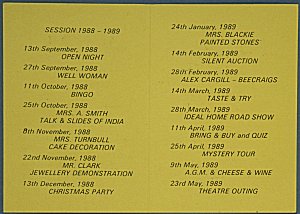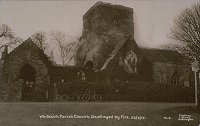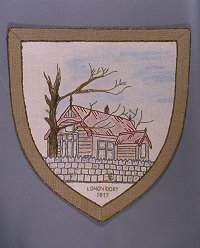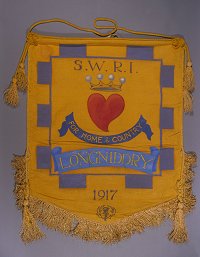Contents ![]() | Institutes of learning
| Institutes of learning ![]() | Sources
| Sources ![]()

The Scottish Women's Rural Institute
Page 1 of 2 | Next
Origins
The emerging suffrage movement of the late nineteenth century did not merely demand the vote for women. It demanded that women be treated as equals. Why should women spend their days behind a stove with no one to speak to whilst their husbands lingered around the local water fountain or pub? So, from the late nineteenth century a number of women's groups emerged in Scotland. They included the Scottish Co-operative Women's Guilds and the Townswomen's Guild but the SWRI has proven to be the most popular.
The first ever Women's Institute was organised at Stoney Creek in Ontario, Canada in 1897. The movement spread throughout the world and arrived in Wales in 1910 and England in 1915. The idea finally took tangible form in Scotland twenty years after it was born in Canada.

Catherine Blair
Catherine Blair (1872-1946) lived at Hoprig Mains Farm near Gladsmuir. In the early years of the 20th century she was a suffragette. Blair's campaign was one of reasoning rather than action. She wrote hundreds of letters to the Scottish press supporting the cause of the Women's Social and Political Union (WSPU). She also supported the radical wing of the movement, noting that it was only her family life that stopped her involvement in action. In 1914, for example, she defended the right of the suffragettes to burn Whitekirk Church. She argued that they had been driven to such action by a government intent on ignoring the suffrage issue.

By 1917 Catherine Blair was fully aware that women were tied to their homes and families with few, if any, social outlets. Then, inspired by her dairymaid, who complained that, "[Men] are aye meetin' their neebors in the stable an' passin' the time o' day wi' the maister ... but for the likes o' me, there's never a body to speak to," she decided that this problem needed to be remedied.
She picked up on the emerging 'institutes' and determined to launch a Scottish example. Macmerry, near her home, was intended to be the first but there was an outbreak of measles in the village. The event, therefore, was moved to the reading room at Longniddry. Blair and a Canadian institute member, Mrs Madge Watt, laid out their case. After Mrs Watt finished speaking the room fell silent until Mrs Isabella Bathgate stood up and said, "I propose we have a Rural Institute like those in Canada here, in Longniddry." And thus Scotland's first Rural Institute was formed. Thirty-seven women joined on the first evening and Lady Wemyss was installed as Honorary President.

Blair threw herself into publicising the new institute. Adapting suffragette slogans and adding her own telling phrases she spun sound-bite after sound-bite to get the message across: 'Deeds Not Words', 'for Home and Country', 'if you know a good thing pass it on' and 'we grow Scottish, we make Scottish and we sell Scottish'.
Page 1 of 2 | Next
In this section:
Women's Co-operative Guilds | Scottish Women's Rural Institute | Literary and debating societies
Contents ![]() | Institutes of learning
| Institutes of learning ![]() | Sources
| Sources ![]()